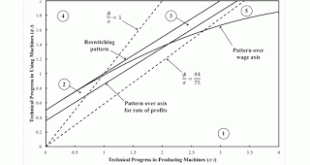I have defined patterns of switch points in considering perturbations of examples of the choice of technique. For example, I have defined three-technique and four-technique patterns. An obvious extension is to consider how these patterns arise in models of joint production. A simplification is to only consider models of fixed capital without superimposed joint production. This post lays out an example in which, maybe, some parameter values can lead to a three-technique pattern. I am...
Read More »A Bowles Taxonomy For Economists
[embedded content]Katzner, Bowles, and Resnick on UMass Amherst Shartly after about 32:30 minutes, Sam Bowles, to laughter, draws a Venn diagram on the board. This is a light talk, and Bowles is explicitly describing economics from his own experience at the University of Massachusetts at Amherst. Bowles places various economists in various subsets. I have varied the names a bit in my reproduction below. Bowles' Taxonomy I take the universe to be the set of all economists. Or, maybe,...
Read More »Economics Of Race And Other Economics For Others
Do economists have anything to say about racism in the United States? Some do. The Review of Black Political Economy, for example, exists. Other groups in the United States are often thought of as marginalized. I have written about women in economics before. As usual, I want to mention the existence of the International Association for Feminist Economics and their journal Feminist Economics. I also note the existence of Queer Economics: A Reader for those economists that might be of a...
Read More »Some Positions Some Take On Sraffa’s Book
This post lists some views on Production of Commodities by Means of Commodities: A Prelude to a Critique of Economic Theory. The quantity flows Sraffa takes as given are those observable in an actual economy at a given time, as with a snapshot (Roncaglia 1978). These quantity flows, on the contrary, are at the level of effectual demand (Garegnani 1990). These quantity flows are for an economy in a self-replacing state. The assumption of constant returns to scale is necessary for drawing...
Read More »A John Eatwell Lecture
[embedded content]John Eatwell On Why Economists Disagee I like the above lecture by John Eatwell. He concludes by talking about the partial equilibrium model of supply and demand "that we teach, and we justify it by the general equilibrium model". He notes that lots of economists put imperfections in. The Arrow-Debreu is currently the fundamental model of price theory among mainstream economists. According to Eatwell, economists fall into at least five groups. Those who think revisions...
Read More »A Letter To Sraffa Long Before Google
At this time, the book had long ago been published by Cambridge University Press. I suppose I ought to review whatever conditions exist on transcribing stuff in the archives. The following is D3/12/111:9. Routledge & Kegan Paul Ltd. October 15th 1969 Professor Piero Sraffa, Trinity College, CAMBRIDGE Dear Professor Sraffa, At the Frankfurt Book Fair last week, Einaudi told me about your "Produzione di merci a mezzo di merci". I don't know whether this has been published in...
Read More »Extracts From LBJ Announcement Of The Appointment Of The Kerner Commission
My fellow Americans: We have endured a week such as no Nation should live through: a time of violence and tragedy. For a few minutes tonight, I want to talk about that tragedy - and I want to talk about the deeper questions it raises for us all. I am appointing a special Advisory Commission on Civil Disorders. Governor Otto Kerner, of Illinois, has agreed to serve as Chairman, Mayor John Lindsay, of New York, will serve as Vice Chairman... The Commission will investigate the...
Read More »More On A Fixed Capital Example
Figure 1: A Partition of a Parameter Space for the Schefold Example1.0 Introduction I want to revisit a perturbation analysis of an example, from Bertram Schefold, of reswitching with fixed capital. Suppose workers use a machine to produce something or other, where the machine lasts several production periods. It is a possible choice to run the machine for less than its full physical life. One might think than choosing to adopt a technique with a longer economic life of the machine...
Read More »Financial Economics
This is a list of some of what I think one should know if one wants to talk to investors interested in theory. This post is not about making money and is probably not up-to-date. My references are fairly popular, and mostly old. I include one recent popular book as an example. Most of the references I do not recall very well, and I have not read Ben Graham. But many seem to know that Warren Buffet recommends this book. This post is non-critical. Keen and Quiggin in Debunking Economics and...
Read More »Elsewhere
A podcast interview with Philip Mirowski about how, roughly, neoliberals are exploiting the Corona Virus crisis in America. A book, Nine Lives of Neoliberalism, edited by Dieter Plehwe, Quinn Slobodian, and Philip Mirowski. Somewhere this is or was freely downloadable in PDF. A podcast interview with Marshall Steinbaum about the Chicago school of economics. A podcast episode, by two economics professor, trying to present an overview of Joan Robinson. A downloadable book, Labour and Value:...
Read More » Heterodox
Heterodox


